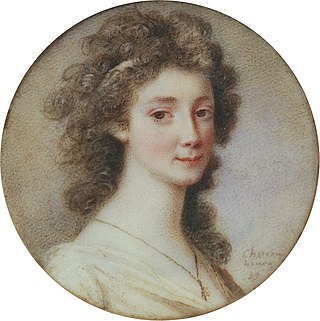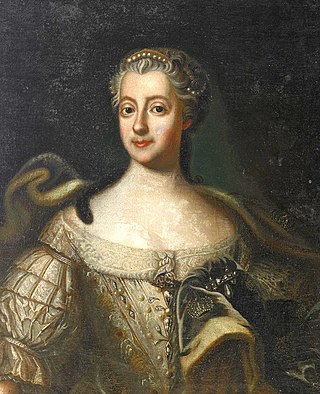
Gustav IV Adolf or Gustav IV Adolph was King of Sweden from 1792 until he was deposed in a coup in 1809. He was also the last Swedish monarch to be the ruler of Finland.

Prince Gustav of Vasa, Count Itterburg, born Crown Prince of Sweden, was the son of King Gustav IV Adolf of Sweden and Queen Frederica. His Austrian princely title was actually spelled Wasa.
The Närke-Värmland Regiment was a Swedish Army infantry regiment that traced its origins back to the 16th century. It was split into two new regiments in 1812. The regiment's soldiers were recruited from the provinces of Närke and Värmland.

Carl Johan Adlercreutz was a Swedish (Finnish) general and statesman, born in Borgå, Finland on family estates. Entering the Swedish army aged 13 in the Finnish Light Cavalry Brigade, he was present when Gustav III launched his coup-d’etat. He studied military theory in Stockholm.

Princess Sophia Albertina of Sweden was the last Princess-Abbess of Quedlinburg Abbey, and as such reigned as vassal monarch of the Holy Roman Empire.

Charles August or Carl August was a Danish prince. He is best known for serving as Crown Prince of Sweden briefly in 1810, adopted by Charles XIII, before his sudden death from a stroke. Earlier, he had been a general in the Royal Danish Army as well as the Governor-general of Norway. His name before assuming the Swedish title in 1810 was Christian August of Schleswig-Holstein-Sonderburg-Augustenburg, or Christian August of Augustenburg for short.

Countess Eva Sophie Piper, née Eva Sophie von Fersen, was a Swedish countess and lady in waiting. She was the daughter of count Axel von Fersen the Elder and Hedvig Catharina von Fersen and the sister of Axel von Fersen the Younger, Hedvig Eleonora von Fersen and Fabian von Fersen (1762–1818). She is foremost known for her close friendship with Queen Hedvig Elizabeth Charlotte, who dedicated her famous diary to her.

Hedwig Elisabeth Charlotte of Holstein-Gottorp was the queen consort of Charles XIII of Sweden and II of Norway. She was also a famed diarist, memoirist and wit. She is known as Hedwig Elisabeth Charlotte, though her official name as queen was Charlotte (Charlotta).

Prince Frederick Adolf, Duke of Östergötland was a Swedish Prince, youngest son of King Adolf Frederick of Sweden and Louisa Ulrika of Prussia, a sister of Frederick the Great, King of Prussia. He was given the title Duke of Östergötland.

Count Wilhelm Mauritz Klingspor was a Swedish noble military officer and one of the Lords of the Realm. He is probably best known from his time as field marshal of Finland during the Finnish War, where his command of the Swedish army contributed to the Swedish loss. He is also known for participating in the coup of 1809 that dethroned Gustav IV of Sweden.

The Lord of the Realm was a title of honour introduced by Gustavus III, King of Sweden shortly after his coup and the newly passed constitution. The title was granted by the King and was first received by Frederick William, Prince von Hessenstein on 15 January 1773 by letter. One of the most famous title holders was Hans Axel, Count von Fersen, the supposed lover and confidant of Marie Antoinette, Queen of France.

Lovisa Sofia Augusti was a Swedish opera singer (soprano). She was regarded as one of the most noted opera singers of the Royal Swedish Opera during the Gustavian era. She was appointed Hovsångare in 1773 and inducted to the Royal Swedish Academy of Music in 1788.

Count Carl Lewenhaupt was a Swedish diplomat and politician, who was Minister for Foreign Affairs from 1889 to 1895.

Adolf Fredrik, Count Munck, was a Swedish and Finnish noble during the Gustavian era. His family name is sometimes inaccurately given as "Munck af Fulkila" because his father usurped this family's title in the Swedish Diet but, as a matter of fact, without genealogical justification.

Carl August Adlersparre was a Swedish count (1835), chamberlain (1838), poet, novelist and historian from the Adlersparre family. He was known under his pen name Albano.
Count Fabian Reinhold von Fersen was a Swedish count, politician, officer and courtier. He was the son of Axel von Fersen the Elder and Hedvig Catharina De la Gardie and the brother of Count Axel von Fersen the Younger, Hedvig Eleonora von Fersen and Sophie Piper.

The Coup of 1756 was an attempted coup d'état planned by Queen Louisa Ulrika of Sweden to abolish the rule of the Riksdag of the Estates and reinstate absolute monarchy in Sweden. The attempted coup was exposed and subdued in 1756 shortly before it was due to be put in action. It caused a rift between the royal house and the parliament.

The Coup of 1809 also referred to as the Revolution of 1809 was a Swedish coup d'état 13 March that year by a group of noblemen led by Georg Adlersparre, with support from the Western Army. The coup resulted in the deposition of King Gustav IV Adolf and the introduction of a new Instrument of Government. The coup was provoked by the disastrous Finnish War. The leaders of the coup are known in history collectively as 1809 års män.

The Gustavians were a political faction in the Kingdom of Sweden who supported the absolutist regime of King Gustav III of Sweden, and sought after his assassination in 1792 to uphold his legacy and protect the interests of his descendants of the House of Holstein-Gottorp.

Michael Anckarsvärd was a Swedish count, soldier and politician. After studying at a university he in 1759 got employment at the fortification and participated as an under-officer and officer in the Pommer war. He had employment partly at the field artillery, and partly at the army naval base. After the war he started working for Carl August Ehrensvärd at the new base in Sveaborg. He was one of the first that in 1772 in trust got to know about Gustav III's plans of revolution.
Note: the below sources give an overview of Adlersparre in the English language, but they contain some factual errors.


















